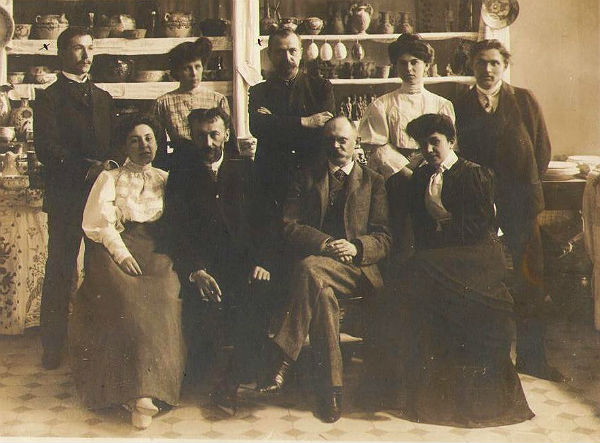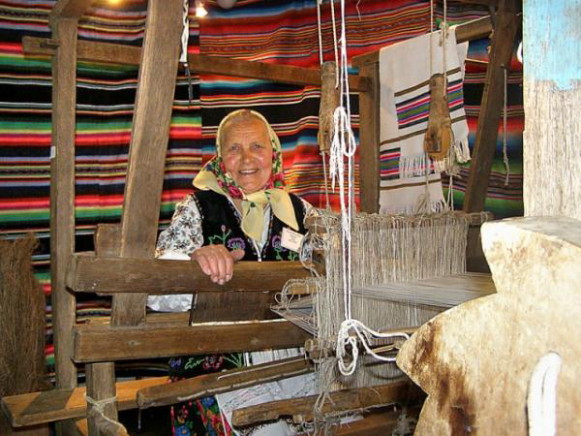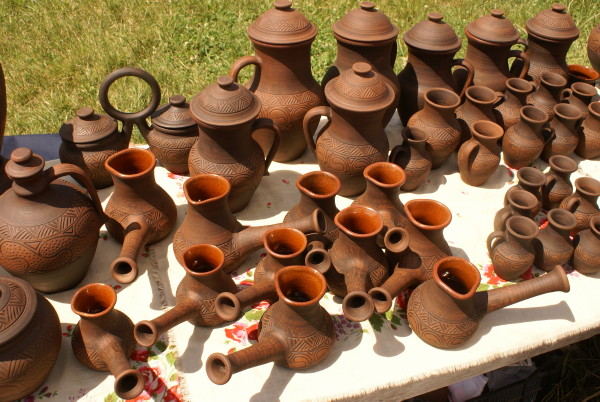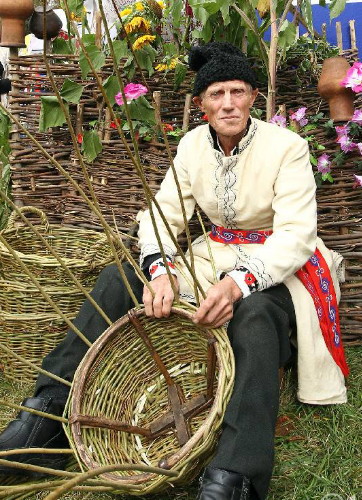Cottage industry
Cottage industry [Кустарна промисловість; Kustarna promyslovist’]. Industry that developed out of home or domestic industry when the surplus production that remained after the producer's needs had been met was sold on the open market. Cottage industry differs from manufacture by the skilled craftsmen in that the latter produce directly to order. For the peasantry cottage industry is a supplementary occupation to the basic work of farming. The producer in cottage industry is the owner of the enterprise, and the closest co-workers consist of the family members. Production takes place mostly in winter, when the peasants have a lot of free time.
In Ukraine cottage industry originated a long time ago. By the end of the 1920s it was widely practiced in the poor, overpopulated regions where factory manufacturing was insufficiently developed and where cheap raw materials were available. Thus, it was widespread in the forest belt, the Carpathian Mountains, and Subcarpathia. Cottage industry was less common in the forest-steppe belt and least common in the steppe belt and Subcaucasia, where the winters were short and there was no agrarian overpopulation. As the population density increased, more and more peasants stopped farming and turned to cottage industry to support themselves. In Poltava gubernia, for example, 58 percent of the peasants made a living in cottage industries. Usually the peasants sold their manufactured products directly at local markets and fairs, but sometimes they transported them to distant markets. Sometimes they sold their wares through middlemen and became dependent on them or even lost their independence completely and sank to the level of ordinary workers, differing from other workers only in that they worked at home.
In Ukraine cottage industries were found in various branches of manufacturing—from the production of ordinary goods for the peasants to the production of artistic artifacts for the more prosperous part of the urban population. Ukraine's cottage industry can be divided into the following branches: woodworking, pottery, spinning and weaving, leather making, and metalworking.
The cottage woodworking industry was concentrated in the forested regions of Ukraine—in northern Ukraine and the Carpathian Mountains—and was less common in the forest-steppe belt. Forest labor such as the collecting of tar and resin and the cutting and sawing of timber was widespread only in Polisia and the Carpathians. The carpentry and woodworking trade produced mostly simple furniture and chests and was practiced most widely in the Poltava region and the Hutsul region. Artistic woodwork was done in both of these regions as well. Cooperage was common everywhere but was particularly important in the forest regions. Wagons and wheels were built mainly in Kyiv gubernia (Chyhyryn, Tarashcha, and Radomyshl), Poltava gubernia (Lubny, Hadiach, and Zinkiv, Poltava gubernia), and Kharkiv gubernia (Sumy and Okhtyrka). Basket weaving was most common in the Chernihiv gubernia, the Kyiv gubernia, the Poltava gubernia, and the Kharkiv gubernia. The baskets and reed furniture made in Sosnytsia, Chernihiv gubernia, were widely sold throughout Ukraine. Pottery was widely practiced throughout Ukraine.
The most important cottage industry was weaving, which produced thick, strong cloth, woolens, tablecloths, towels, kerchiefs, linen sheets, kilims, bedspreads, multicolored linen cloth, and decorative folk towels (see Rushnyk). This cottage industry was most developed in Poltava gubernia, Kyiv gubernia, Chernihiv gubernia, and Kharkiv gubernia. In Galicia the Hutsul region was famous for its woven products. Ukrainian embroidery is a special cottage industry.
Leather making or tanning was widely practiced mainly in Kyiv gubernia (Vasylkiv, Berdychiv, Radomyshl), Chernihiv gubernia (Baryshivka, etc), Poltava gubernia (Zinkiv, Poltava gubernia, Novi Sanzhary, Tsarychanka, and especially Reshetylivka, which was known for its lambskins), Kharkiv gubernia (Okhtyrka, Valky, Nova Vodolaha, Zmiiv), and Galicia (Tysmenytsia, Kuty). Shoemaking and bootmaking usually developed in the leather-producing areas, mostly in Left-Bank Ukraine (see Footwear industry).
Metalworking as a cottage industry was limited to blacksmithing and locksmithing. These were common throughout Ukraine but were particularly developed in the Kharkiv region (Bilovodsk), Chernihiv gubernia and Poltava gubernia. Blacksmiths produced iron-reinforced wagons, plows, harrows, hoes, sickles, and other farm implements.
The importance of the cottage industries before the Revolution of 1917 is indicated by the fact that in 1911–12 they employed 400,000 people in the nine Ukrainian gubernias within the Russian Empire and produced annually 144 million rubles' worth of goods, accounting for slightly more than 10 percent of the total industrial production and 25 percent of the peasant demand for manufactured goods. Because factory manufacturing was not well developed, the cottage industries remained competitive. The government, and particularly the zemstvos, encouraged the development of the cottage industries by providing subsidies, credit, instructors, and so on.
In the first few years following the revolution the cottage industries assumed an even greater importance than before the First World War, because the productivity of the factories had declined. In the mid-1920s the cottage industries accounted for about 20 percent of all manufactured goods and met 40 percent of the peasants' demand. As of 1 October 1928 820,000 peasants and craftsmen were employed in cottage industries in Soviet Ukraine, and only 22.3 percent of them were in co-operatives. According to some rough estimates their production was worth 310 million rubles. Forced collectivization, a shortage of raw materials, and, most of all, exorbitant taxes brought about the decline of the cottage industries. By 1933 there were only 48,000 peasants and artisans employed in cottage industries in Soviet Ukraine. The Soviet authorities forced them to join co-operatives controlled by the government. Co-operative workers in Soviet Ukraine paid an income tax at the same rate as did workers and public employees (1.5–13 percent of their income; in 1960–5 the tax on incomes up to 100 rubles per month was canceled and that on incomes up to 200 rubles per month was reduced). Employees in cottage industries who did not belong to co-operatives had to pay a much higher income tax—from 4 to 81 percent.
Some products of the cottage industries, such as ceramics, kilims, embroidery, and wood carvings, were of a high artistic standard and sometimes shared common features with folk art.
BIBLIOGRAPHY
Rybnikov, A. Kustarnaia promyshlennost' i sbyt kustarnykh izdelii (Moscow 1913)
Floryns'kyi, M. Kustarni promysly na Ukraïni (Kharkiv–Kyiv 1923)
Yevhen Glovinsky, Volodymyr Kubijovyč




